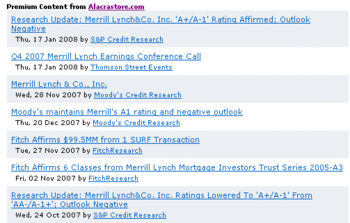Lisa Bodell, CEO of futurethink led the panel discussion on Information Industry Innvators.
The panelists were Jim Brock, CEO of Attributor, Alacra CEO Steve Goldstein and Darrell Gunter, Chief Marketing Officer for Collexis.
Each panelist had 3 minutes and 3 slides with images and no words to describe their business.
Attributor:
- We do heavy lifting; we help track where your content appears anywhere on teh Internet
- We help customers look at the entire internet to put your content out; we are the harvester; we allow you to see how your content is being used, whether there is commercial value being generated, and whether there are links back to your site.
- Why we're innovative - we make lemonade out of lemons. The changes in the content industry
Alacra
- We're a content company - license & aggregate all sorts of biz info and resell it to financial svcs, mgmt consultants and accounting firms; we make money in 2 ways: we resell it on a transaction basis and we also package it
- In essence, we're a packaging company of all this content in variety of different ways.
- Innovation: we get our ideas from our customers; also, we try a lot of new things. How can we apply new technologies?
Collexis:
- Collect key concepts and put them into a fingerprint to be able to show the key concepts within a long document
- What we do - we shine a bright light into information; we can show you who are the subject matter experts in a given area; we also can show the emerging trends that may occur in the future - leads to hypothesis generation (show co-occurring concep ts)
- Innovative because "we make scientists happy"; we save them time
Strategies for innovation:
Lisa: If you were addressing 100 CEO's in the information industry on innovation, what's your top starting point for innovation?
Steve: Many companies are sitting on a wealth of assets that they're not doing anything with. Rather than creating from scratch, we find lots of great opportunities by leveraging things that you already have.
Jim Brock: watch the social networks as a laboratory; if you can gain visibility into how your users are mashing up your info, you gain insights as to how you should be doing things with your data.
Lisa: How do you define innovation?
Steve: it's sort of like pornography; you can't really define it but you know it when you see it. We focus on how we might solve a particular customer problem.
Jim: We had a recent discussion around this. It has to be something non-obvious. But, it could be something non-technical. It could be administrative, legal or something else.
Lisa: Where do you get the ideas (aha moments) for your business?
Steve: most of our ideas come from the customers; we try to synthesize what customers are doing. It's not an "in the shower" aha moment. It's more that we synthesize things from multiple customers.
Lisa: Once you identify something, how do you get it out the door? Do you dedicate people, money, time?
Darrell: You need to have a champion, then you need to set a plan in place for development, then work with a user-centered design group.
Jim: For me, it's people & machines. How many people are on something; how much of their time is dedicated to it and how many machines are working on it.
Lisa: It's hard to get people to be innovative. What do you do to encourage innovation?
Steve: we try to get as many of our employees out of the office as is possible. It's hard to be creative when you're in your comfort zone in our office.
Darrell: We have the opposite problem. We have a lot of innovative people that generate lots of ideas but we have to narrow them down.
Lisa: Name a company you aspire to, outside of your industry
Steve: Evan Williams, who invented Twitter; you take something that already exists (blogging) and made it smaller by limiting the number of users.
Jim: LinkedIn; I go to it every few weeks and always find it interesting
What are your New Year's Resolutions for your business?
Jim: we have to get as close as possible to the customer. For us, it's about opening the API up to the customer.
Steve: similar in terms of speaking with more customers; but for this years it's more getting out of our sweet spots to find prospects who have similar problems to our customers
Darrell: Goal is to be in the top 100 institutions in the United States




 Research Recap, launched by Alacra last summer, has unveiled the 10 most widely read posts of 2007.
Research Recap, launched by Alacra last summer, has unveiled the 10 most widely read posts of 2007.


